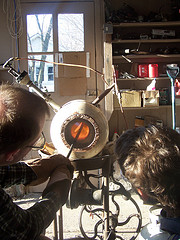History of Welding and Metallurgy - Part 1
 For you students out there doing a report on the history of welding, let me first say this…I have always found the earliest history of welding to be kind of boring. But I remember back to high school when my ears perked up in history class at the first mention of longbows. So I will try to make this interesting by talking about swords and airplanes.
For you students out there doing a report on the history of welding, let me first say this…I have always found the earliest history of welding to be kind of boring. But I remember back to high school when my ears perked up in history class at the first mention of longbows. So I will try to make this interesting by talking about swords and airplanes.
This is actually more like the history of metallurgy. I will save the history of welding for Part 2
Let's get the boring stuff out of the way first. None of these dates are hard facts and I am probably going to omit some important terms like «Paleolithic» but that's how we roll up in here. So Here goes.
From the very beginning of mankind, up until about 8000 BC, was known as the Stone age.
Up until about 8000 BC, stone was used to make cutting tools and spear heads and things like that. Even though copper was discovered during the stone age, it was too soft to use for tools and weapons.
Around 3500 BC, someone discovered that adding tin to copper produced a much harder metal than pure copper and that began what is known as the Bronze Age.
Bronze swords and knifes were used until around 1500 BC when the process of refining iron ore into useable iron was discovered. Then began the iron age.
So this timeline gives a basic view of what makes up the stone age, bronze age, and iron age.
Boring right? Well think about this… not every country, tribe, or race discovered iron at the same time.
Let's say you are living in the city of Troy. You are a foot soldier and you have the latest and greatest bronze sword at your side. You think you are high tech. Your shield is also made out of bronze and easily stops the strongest of blows from other bronze swords .
You are making ready for battle when you get a report from a scout that the neighboring Trojans have developed a magic metal sword that will cut your sword in half and that will penetrate your shield.
You shrug it off as war propaganda but that little tidbit of information lingers in the back of your mind.
It's time to go to war now. Your adrenaline is pumping, war cries are heard, horns are blown and you rush the enemy. You expect certain victory but when you start tripping over your own soldiers and notice they are holding shiny bronze swords that have been cut in half, you remember the story about the magic metal. Oh snap!
It's a bad day for the guys with the bronze swords when they go into battle against iron swords.
I hope things are becoming a little less boring…
Now Fast forward to 2009. A fighter pilot flying an F 22 raptor is about to engage in a dogfight. He knows there are limits to how much throttle he can give to out maneuver his enemy. Too much throttle under the wrong conditions will overtemp the turbine blades and make them soft and unstable and maybe even blow up the motor.
And what if his enemy is flying a fighter jet that uses a new alloy that would allow for an increase of several hundred degrees before they reached overtemp condition? He could put the hammer down without worrying about overtemping.
Would that give a pilot a distinct advantage? It might be just like a bronze sword against an iron sword.
The more things change the more they stay the same.





Рейтинг популярности - на эти заметки чаще ссылаются:
- 43 Герой социалистического труда
- 42 Известный телеведущий целую неделю снимал о Южном Урале
- 41 Первый чугун на каменном угле
- 39 Механизация очистки горновых канав
- 38 Замена конвейерных лент
- 36 Отработка верхнего шлака
- 34 Безотходное производство чугуна
- 33 Металлургия России: всем выйти из кризиса Читать полностью:
- 33 Ремонты чугунных и шлаковых канав
- 33 Системы программного управления